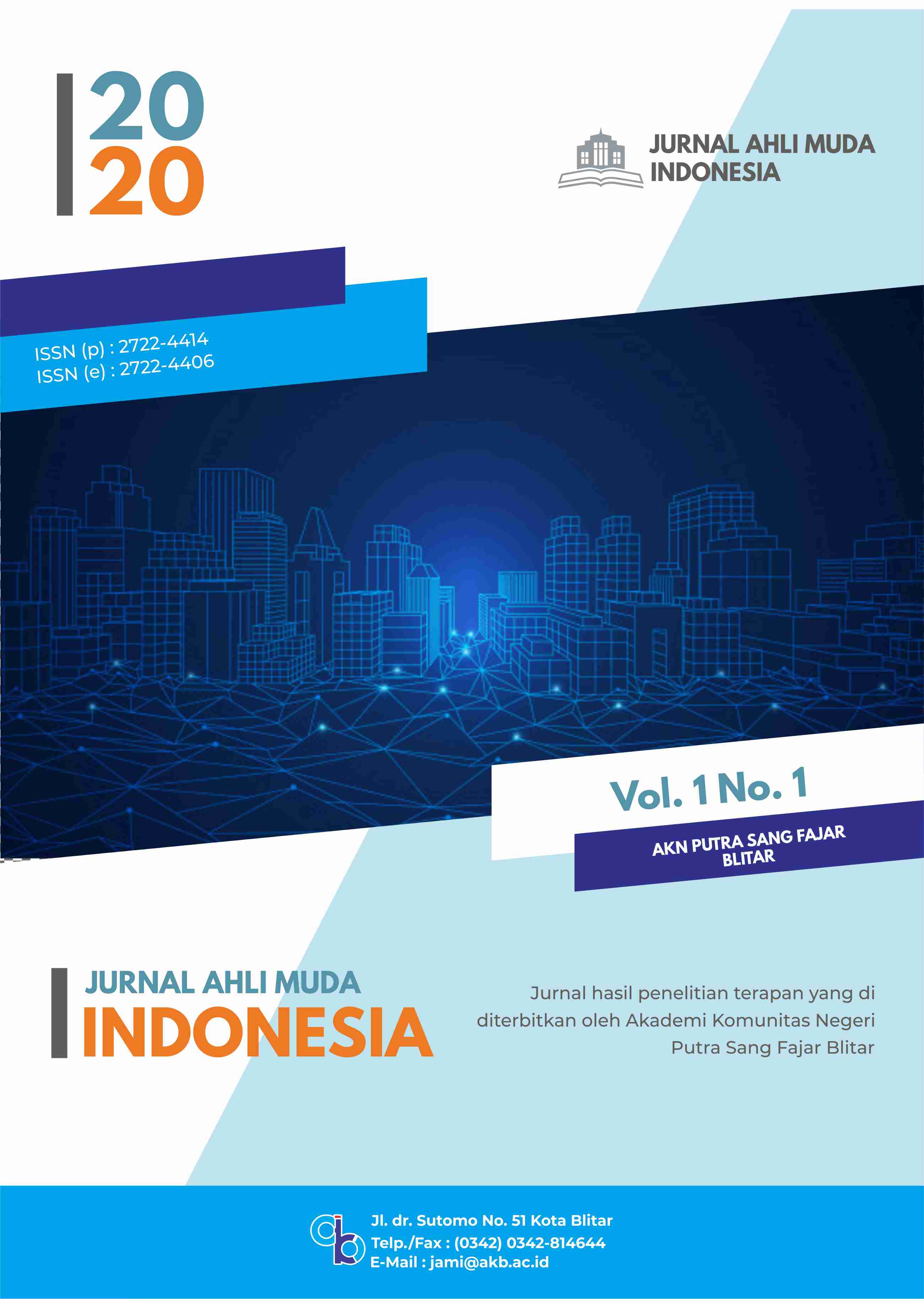Rekayasa Klasifikasi Pencarian Abstrak Tentang Mikrokontroler e-Journal Instek dengan Algoritma Naive Bayes
 Abstract views: 590
,
Abstract views: 590
,
 PDF downloads: 502
PDF downloads: 502
Abstract
Abstrak
Objektif. Jurnal Instek merupakan jurnal elektronik yang ada di Teknik Informatika UIN Alauddin Makassar. E-Journal merupakan representasi elektronik sederhana dari jurnal. Dalam kebanyakan kasus peningkatan volume informasi yang berbentuk E-Journal menimbulkan kesulitan untuk mengelompokkan E-Journal sesuai dengan kategorinya. Berdasarkan hal tersebut maka dirancang sebuah website untuk mengelompokkan E-Journal agar sesuai dengan kateogrinya, pengelompokkan E-Journal terdiri dari empat kategori yaitu, Data Mining, Game, Multimedia, dan Sistem Informasi, sehingga mempermudah seseorang untuk mengelompokkan E-Journal sesuai dengan kategorinya.
Material and Metode.. Dalam penelitian ini, jenis penelitian yang digunakan adalah penelitian deskriptif kualitatif adapun metode kualitatif. Adapun metode perancangannya menggunakan unified modeling (UML). Analisis yang dilakukan mencakup analisis sistem yang berjalan dan analisi sistem yang diusulkan.
Hasil. Hasil penelitian ini berupa website yang dapat mengelompokkan E-Journal berdasarkan klasifikasi. Sistem yang dibangun menggunakan algoritma Naïve Bayes untuk mengelompokkan atau mengklasifikasikan E-Journal.
Kesimpulan.. Berdasarkan hasil perhitungan Klasifikasi sampel data 1 diperoleh 0,0666 sebagai jumlah tertinggi dengan kategori Mikrokontroller.
Abstrak
Objektive. Instek Journal is an electronic journal in the Informatics Engineering UIN Alauddin Makassar. E-Journal is a simple electronic representation of a journal. In most cases an increase in the volume of information in the form of an E-Journal makes it difficult to group the E-Journal according to its category. Based on this, a website is designed to classify E-Journal to fit its category, the grouping of E-Journal consists of four categories, namely, Data Mining, Games, Multimedia, and Information Systems, making it easier for someone to group E-Journal according to its category.
Materials and Methode. In this research, the type of research used is descriptive qualitative research as for the qualitative method. The design method uses unified modeling (UML). The analysis carried out includes analysis of the running system and analysis of the proposed system.
Results. The results of this study in the form of a website that can classify E-Journal based on classification. The system is built using the Naïve Bayes algorithm to classify or classify E-Journal.
Conclusion Based on the calculation results of the classification of sample data 1 obtained 0.0666 as the highest number with the category of microcontroller
Downloads
References
Anggara, Afwan. “Entity Relationship Diagram (ERD )”. http://infokah.com/cara-membuat-erd-tahapan-dan-studi-kasus/. (23 Oktober 2018)/
Andini, Silfia. 2013. “Klasifikasi Dokumen Teks Menggunakan Algoritma Naive Bayes Dengan Bahasa Pemprograman Java.” Teknologi Informasi & Pendidikan 6(2):140–47.
Aprianti, Winda and Umi Maliha. 2016. “Sistem Informasi Kepadatan Penduduk Kelurahan Atau Desa Studi Kasus Pada Kecamatan Bati-bati.” 2(2013):21–28.
Asian, J., 2007. Effective Techniques for Indonesian Text Retrieval. PhD. Royal Melbourne Institute of Technology University.
Bustami. 2014. “Penerapan Algoritma Naive Bayes.” 8(1):884–98.
Darmadi. 2013. “Metode Penelitian(Studi Kasus).” Metode Deskriptif (April 2015):31–46.
Efendi, Zuliar and Mustakim. 2017. “Text Mining Classification Sebagai Rekomendasi Dosen Pembimbing Tugas Akhir Program Studi Sistem Informasi Zuliar.” 18–19.
Fathan Hidayatullah, Ahmad and Muhammad Rifqi Ma. 2016. “Penerapan Text Mining Dalam Klasifikasi Judul Skripsi.” Seminar Nasional Aplikasi Teknologi Informasi (SNATi) Agustus 1907–5022.
Firdaus, A., Ernawati, & Vatresia, A. (2014, April). Aplikasi Pendeteksi Kemiripan Pada Dokumen Teks Menggunakan Algoritma Nazief & Adriani Dan Metode Cosine Similarity. Jurnal Teknologi Informasi, 10 Nomor 1, 1-14
Firman, Astria, Hans Wowor, and Xaverius Najoan. 2016. “Sistem Informasi Perpustakaan Online Berbasis Web.” Jurnal Teknik Elektro Dan Komputer 5(2):29–36.
Gata, Windu. 2017. “Akurasi Text Mining Menggunakan Algoritma K-Nearest Neighbour Pada Data Content SMS-Gateway.” Jurnal Format 6(5):1–5.
G. Urva dkk. n.d. “Pemodelan UML E- Marketing Minyak Goreng.” (9):92–101.
Hartono, Hamzah. 2014. “Pengertian Website Dan Fungsinya.”
Hendini, Ade. 2016. “Pemodelan UML Sistem Informasi Monitoring Penjualan Dan Stok Barang (Studi Kasus Distro Zhezha Pontianak).” IV(2):107–16.
Heriyanto, Yunahar . Perancangan Sistem Informasi Rental Mobil Berbasis Web Pada Pt.Apm Rent Car. Jurnal , Manajemen Informatika, AMIK Mahaputra Riau,2018
Hidayatullah, Priyanto, dan Jauhari K. Kawistara. Pemrograman Web. Bandung : Informatika Bandung, 2015.
Latif, Syukriyanto. 2018. “Text Mining for Classification of Sontent Abstract Journal English Using Dimensional Reduction Method and Naive Bayes.”
Mariadi, Andi. 2016. “Pengertian Sublime Text Editor” (online), (http://study-newbie.blogspot.com/2016/03/pengertian-sublime-text-editor.html )
Mauko, Imanuel Christian, Nicodemus Mardanus Setiohardjo, and Fredrik Paulus Noach. 2017. “Pengembangan Website Unit Penelitian Dan Pengabdian Kepada Masyarakat Dan Penerapan Jurnal Elektronik Berbasis Open Source Di Politeknik Negeri Kupang.” Jurnal Ilmiah Flash 3(2):100–108.
Melita, Ria, Victor Amrizal, Hendra Bayu Suseno, Taslimun Dirjam, Program Studi, Teknik Informatika, and Fakultas Sains 2018. “(TF-IDF) dan cosine similatiry pada sistem temu kembali informasi untuk mengetahui syarah hadits berbasis web (Studi kasus: Syarah Umdatil Ahkam).” 11(2).
Pressman, R. S. (2010). Software engineering : a practitioner’s approach seventh edition. New York: McGrawHill
Authors who publish with this journal agree to the following terms:
1. Copyright on any article is retained by the author(s).
2. The author grants the journal, right of first publication with the work simultaneously licensed under a Creative Commons Attribution License that allows others to share the work with an acknowledgment of the work’s authorship and initial publication in this journal.
3. Authors are able to enter into separate, additional contractual arrangements for the non-exclusive distribution of the journal’s published version of the work (e.g., post it to an institutional repository or publish it in a book), with an acknowledgment of its initial publication in this journal.
4. Authors are permitted and encouraged to post their work online (e.g., in institutional repositories or on their website) prior to and during the submission process, as it can lead to productive exchanges, as well as earlier and greater citation of published work.
5. The article and any associated published material is distributed under the Creative Commons Attribution-ShareAlike 4.0 International License




